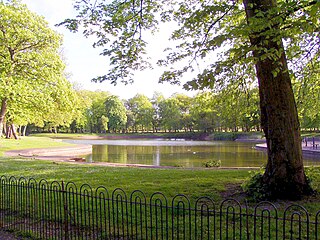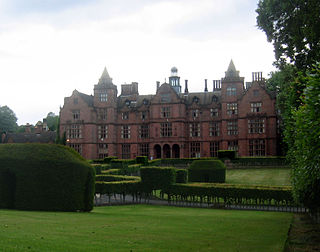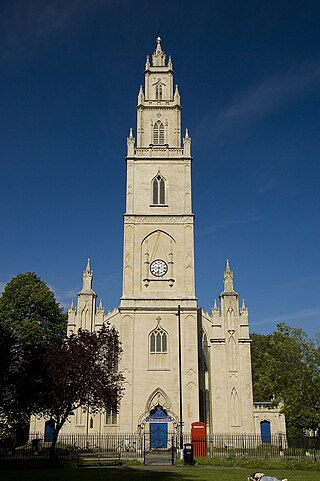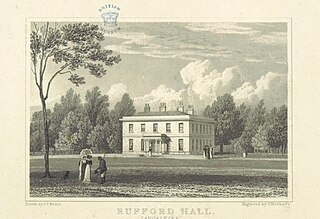
Lingfield is a village and civil parish in the Tandridge district of Surrey, England, approximately 23 miles (37 km) south of London. Several buildings date from the Tudor period and the timber-frame medieval church is Grade I listed. The stone cage or old gaol, constructed in 1773, was last used in 1882 to hold a poacher.

Ashton Court is a mansion house and estate to the west of Bristol in England. Although the estate lies mainly in North Somerset, it is owned by the City of Bristol. The mansion and stables are a Grade I listed building. Other structures on the estate are also listed.

Newsham Park in Liverpool, England is a 121 acres (49 ha) Victorian public park. To the east of it is the Canada Dock branch railway line, and to the north is West Derby Road. The park is protected as a Grade II* listed site.

Old Catton is a suburban village and civil parish in the English county of Norfolk which lies 2 miles (3.2 km) to the north-east of central Norwich. The parish is bounded by the Norwich International Airport at Hellesdon to the west and Sprowston to the east. The northern boundary is with the village of Spixworth while the A1042 road forms the southern boundary. It covers an area of 2.33 km2 (0.90 sq mi) and had a population of 5,954 in 2,512 households at the 2001 census, increasing to a population of 6,108 in 2,666 households at the 2011 Census. For the purposes of local government, it falls within the district of Broadland. The village is twinned with the French commune of Lavaré.

Glenside campus is the home of the Faculty of Health and Applied Sciences at the University of the West of England, in Bristol. It is located on Blackberry Hill in the suburb of Fishponds. Its clocktower is a prominent landmark, visible from the M32 motorway. Several of the buildings on the site are Grade II listed.

Hewell Grange is a former country house in Tardebigge, Worcestershire, England. "One of the most important late 19th century country houses in England", the mansion was built between 1884 and 1891 by George Frederick Bodley and Thomas Garner for Robert Windsor-Clive, later first Earl of Plymouth. Constructed in the Jacobethan style, it was "perhaps the last Victorian prodigy house". After the Second World War, the third earl sold the Hewell estate to the Crown and it was redeveloped as a prison. The mansion was used to house young offenders, and later low-risk prisoners, while adult prisons were built in the grounds. The site was subsequently consolidated as HM Prison Hewell. In 2019, the Ministry of Justice announced the closure of the Category D open prison housed in Hewell Grange, after a highly critical report by Her Majesty's Inspectorate of Prisons.

Castletown is a small village in Underhill on the Isle of Portland in Dorset. It is located close to Fortuneswell, on the shores of Portland Harbour, and includes a sandy beach, as well as one of Portland's notable highlights; Portland Castle, while the Weymouth and Portland National Sailing Academy is also located nearby.
Brentry is a suburb of north Bristol, England, between Henbury and Southmead which is spread along the southern edge of the Filton to Avonmouth railway line.

Claybury Hospital was a psychiatric hospital in Woodford Bridge, London. It was built to a design by the English architect George Thomas Hine who was a prolific Victorian architect of hospital buildings. It was opened in 1893 making it the Fifth Middlesex County Asylum. Historic England identified the hospital as being "the most important asylum built in England after 1875".

Axwell House is a mansion house and Grade II* listed building, at Axwell Park, Blaydon, Tyne and Wear, England.

St Paul's Church, a redundant church, gives its name to the surrounding St Paul's area of Bristol, England. It was built in the 1790s but fell into disuse and disrepair by its closure in 1988. It is recorded in the National Heritage List for England as a designated Grade I listed building.

Leigh Court is a country house which is a Grade II* listed building in Abbots Leigh, Somerset, England. The grounds and park are listed, Grade II, on the Register of Historic Parks and Gardens of special historic interest in England.

Rufford New Hall is a former country house that belonged to the Heskeths who were lords of the manor of Rufford, Lancashire, England. It replaced Rufford Old Hall as their residence in 1760. From 1920 to 1987 it was used as a hospital and has subsequently been restored and converted for residential use. It was designated a Grade II listed building in 1986.

Catton Park is a Grade 2 listed public park located in the village of Old Catton some 2 miles (3.2 km) north of central Norwich. The park covers 70 acres (28 ha) and was landscape gardener Humphry Repton's first commission. Adjacent, but outside the boundary of the present today park are two open spaces; the War Memorial Deer Park at Spixworth Road and the Buttercup Meadow at the junction of Oak Lane and Spixworth Road. Both were historically part of Catton Park and together with Catton Hall form part of the Old Catton conservation area.

The Dower House, Stoke Park is a dower house in Bristol, England. It is one of Bristol's more prominent landmarks, set on Purdown, a hill above the M32 motorway on the main approach into the city, and painted yellow.
Healthcare in the city of Bristol, England and the surrounding area is largely provided by the National Health Service (NHS). Until July 2022, this was provided through the Bristol, North Somerset and South Gloucestershire clinical commissioning group. Facilities include a large teaching hospital – Bristol Royal Infirmary – which offers nationally commissioned specialist cardiac, cancer and children's services from its city-centre campus to patients in the southwest of England and beyond.

Stoke Park Hospital, was a large hospital for the mental handicapped, closed circa 1997, situated on the north-east edge of Bristol, England, just within South Gloucestershire. Most patients were long-term residents, both adults and children of all ages. A school was on-site. Prior to 1950, it was known as the Stoke Park Colony, which was founded in 1909.

Moseley Hall is a Grade II listed 18th-century country house which was situated in parkland in Moseley, Birmingham. The hall itself is now part of Moseley Hall Hospital and much of the surrounding estate has been developed for roads and housing.

Lancaster Moor Hospital, formerly the Lancaster County Lunatic Asylum and Lancaster County Mental Hospital, was a mental hospital in Lancaster, Lancashire, England, which closed in 2000.
Eagley Mills is a complex of former cotton mills in Eagley, Bolton, England. The complex is adjacent to a model village originally built for the millworkers. The surviving mill buildings have since been converted to residential use.


















